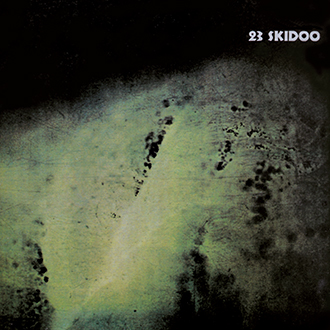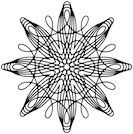23 Skidoo \ The Culling Is Coming [TWI 123]
First released by Les Disques du Crépuscule and Operation Twilight in February 1983, The Culling is Coming flagged two radical new directions for Skidoo following funky indie chart-topper Seven Songs the previous year. Drawn from two extraordinary live performances, Culling combined a collaboration with the Balinese Gamelan Orchestra recorded at Dartington College of Music in October 1982, together with extracts from a more extreme, improvised set at the first WOMAD festival in July 1982, using scrap metal and tape loops. Both sides of the album were exactly 23 minutes long, side one signing off with a stylus-hostile locked groove.
Digitally remastered, The Culling is Coming has now been expanded to include a complete (and equally extreme) 26 minute loop performance at Tielt, Belgium, on 8 October 1982. Recorded as part of Crépuscule's short Move Back/Bite Harder tour with Cabaret Voltaire, Tuxedomoon, Antena and The Pale Fountains. The extended set runs for 76 minutes. The CD booklet features the original artwork along with contextual notes by Skidoo's Alex Turnbull.
Tracklist:
1. G-2 Contemplation
2. S-Matrix
3. G-3 Insemination
4. Shrine
5. Mahakala
6. Banishing
7. Invocation
8. Flashing
9. Stifling
10. Healing (For the Strong)
11. Move Back/Bite Harder
Available on CD and digital (MP3 or FLAC). CDs ordered direct from the label are dispatched in a special LDDC slipcase. To order any format please first select correct shipping option (UK, Europe, Rest of World) and then click on Add to Cart button below cover image.
Or, you can order with the option of tracked shipping from our friends at Burning Shed (click here to order)
Reviews:
"Some things never go out of fashion. The first half of The Culling Is Coming - subtitled A Winter Ritual - consists of surprisingly ambient pieces, based around gamelan's unique tones. Having lulled us into a false sense of chilled-out security, the later tracks - under the header of A Summer Rite, recorded at WOMAD - operate in a far more industrial/electronic space. Saxophones get mangled amid jarring white noise on Banishing, while Invocation consists of William Burroughs-esque looping voices and plunging synth tones, everything eventually disintegrating into a sea of distortion on Flashing. The album closes with An Autumn Journey, a disorientating 26-minute live voice collage of confrontational, Throbbing Gristle-ish aesthetics. Almost four decades on, it's still powerfully startling" (Electronic Sound, 11/2021)
"A damn fine piece of work - the perfect non-chemical cure for a headache" (The Wire, 11/2003)
"A genuinely esoteric and intriguing reissue. The ambience remains one of menace rather than ethno-tourism" (Record Collector, 12/2003)
"The mixes are diamond sharp. The Gamelan music drifts serenely across great canyons of nothingness, fairybell tinkling and enormous booming which disregards all forms of rhythm, ideas elongated into an immense drip-feed of sound" (NME, 1983)
"Culling is a densely packed, closed and clenched fist of a record" (Sounds, 1983)
"The WOMAD side offers tape-looped phrases segueing in and out of focus, electronic twitterings and squalling ethnic wind instruments all clawing at each other like an orgy in an abattoir" (Melody Maker, 1983)
"Twenty years on, TCIC remains dislocated and disconnected from anything remotely like western rock n' roll, and remains one of the strangest stylistic U-turns out there. Best approached with a similar zeal to finally seeing A Clockwork Orange at the cinema for the first time" (Whisperin' & Hollerin', 9/2003)

Sleevenote by Alex Turnbull:
Undoubtedly Skidoo's most unorthodox and misunderstood release to date. The original record separates into two distinct and very different sides.
Side 1 is a recording of a live performance at the first W.O.M.A.D. Festival in July 1982, which featured among others the Burundi Drummers, Les Musiciens du Nile and a whole host of musicians from around the world. Skidoo elected not to use traditional instruments but instead to improvise a performance with instruments made of scrap metal and tape loops (at this time, literally looped sections of tape). The ritual of banishing, invocation and healing mirrored the changes that had occurred within the group. Indeed this cycle of renewal is something very basic to the concept of 23 Skidoo.
At 11 am on a sunny summer morning Skidoo, heads shaven, faces camouflaged, took to the stage. The bleary-eyed festival crowd, expecting a trendy funk band, are greeted by a wall of noise. Some flee, those that remain witness Skidoo at their most confrontational. expectations are shattered.
Side 2 shows the other meditative side of skidoo, recorded at Dartington Music College in October 1982 using traditional gamelan instruments. Skidoo travel to Devon for the weekend with a mobile 8 track studio. They spend the next three days and nights improvising and recording rhythms which are later taken to Jacobs studios to edit together and mix, with the assistance of Ken Thomas.
Though intended as a one-off experiment, and no way reflective of the material the group were playing regularly, the LP was universally condemned by the press as too off the wall and left field. Skidoo in typical fashion were totally unconcerned, though this was to make it difficult for them to find labels willing to release such varied material and to deal with artists perceived as being so unpredictable.




